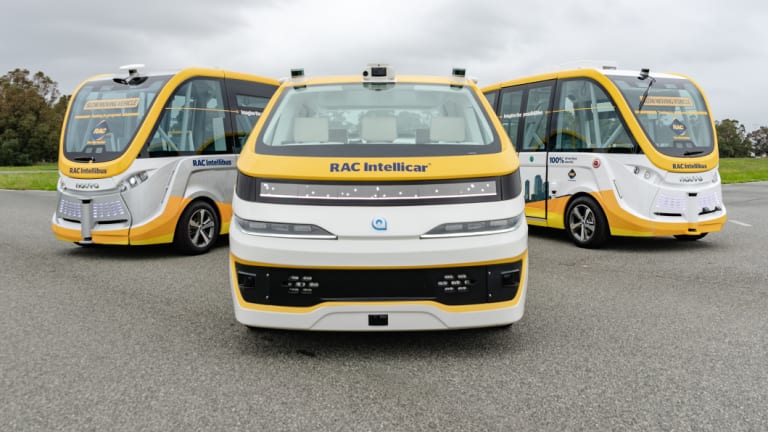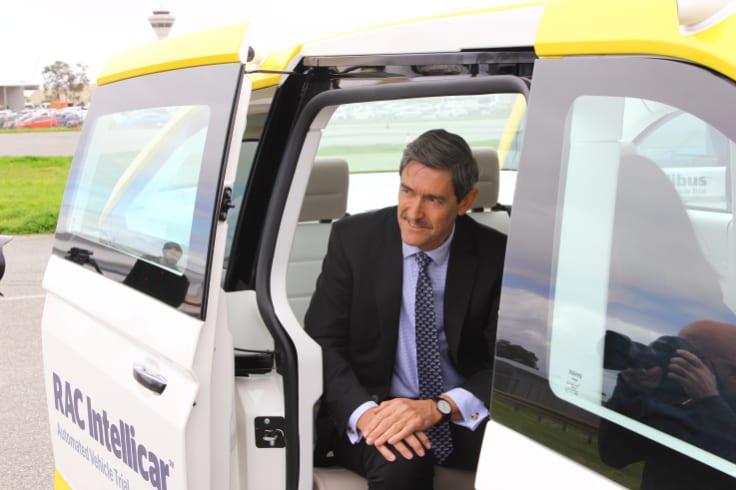
“How we move around is rapidly evolving and being able to test emerging vehicle technologies right here in WA will help us adapt to these changes in the safest way possible,” he said.
Mr Agnew said driverless vehicles had the potential to remove 90 per cent of on road crashes and expected them to become the dominant vehicle on Australian roads within two decades.

The RAC Intellicar is the company's third driverless vehicle.
Photo: RAC"The technology will come anyway, RAC can't stop that, no one can stop it," he said.
"Our role we see is helping our members and the community be ready for it and to be able to use it proactively.
"The benefit at the end is enormous. The benefit is a 90 per cent reduction in crash rates.

RAC group chief executive Terry Agnew in the Intellicar.
Photo: Hamish Hastie“Human error is the cause of the vast majority of road deaths and serious injuries, so if we can help WA and Australia safely transition to driverless vehicles sooner, hundreds of Australian lives could be saved."
The Intellicar trial will be run in three phases. The first phase will take place at RAC's private facility, the second on public roads without passengers and the third in a quieter area with passengers who will be able to summon the car using an app.
In March Uber suspended its driverless vehicle trials in Arizona after one of its cars killed a pedestrian.
Mr Agnew said at all times during the Intellicar trials there would be a human on board who could manually disable the car. He said it would be run at about 20 to 40km/h, markedly less than the car's top speed of 90km/h.
The Intellicar is not RAC's first foray into the driverless vehicle space.
In August 2016 it launched the slow-speed Intellibus trial on the South Perth foreshore. To date more than 14,000 people have ridden the bus.
Executive general manager of advocacy and members Pat Walker said the Intellicar had about three times the technology of the two Intellibuses but would also take a lot more effort in getting approval to drive on the road.
"There's a lot of approvals. I think we acquired 78 different approvals, Commonwealth and state, for the bus. unfortunately its not getting any easier," he said.
"It is a huge step up. The buses have done a tremendous job mixing with cars and pedestrians and dogs and other things on the foreshore, but the car will be roaming so the terrain and conditions change."
The Intellibuses has two LIDAR devices that work in a similar fashion to RADARs but with light.
The Intellicar features 10 LIDARS, 6 cameras, 4 RADARs and two global navigation systems that help it spot and avoid any obstacles.
"Stopping is what they do really well," Mr Walker said.
RAC will take delivery of two more Nayva Intellicars before the end of the year.
NAVYA chief executive Christophe Sapet said Australia was a strategic place to test, showcase and deploy new technologies in the region.
"The government’s, as well as RAC’s, enthusiasm for new vehicle technology, innovation and the need to make smart mobility solutions readily available to the community in this part of the world has led us to confirm one of our trials here in WA.”
Over coming months RAC will work with the state government to identify potential trial locations.
Hamish is a reporter writing for WAtoday in Perth.









 Add Category
Add Category